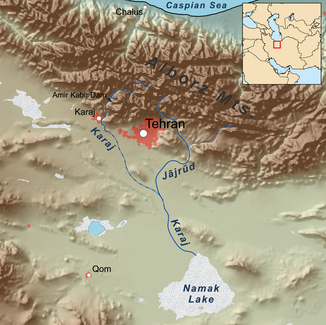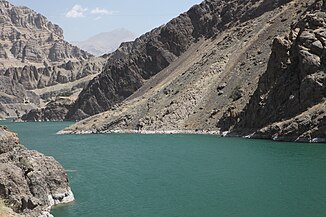Karaj (river)
| Karaj | ||
|
Topographic map of the course of the river |
||
| Data | ||
| location | In the north of Iran | |
| River system | Karaj | |
| source | In the central Elburs Mountains | |
| muzzle | east of Qom in the Namak Sea Coordinates: 34 ° 46 ′ 50 ″ N , 51 ° 49 ′ 51 ″ E 34 ° 46 ′ 50 ″ N , 51 ° 49 ′ 51 ″ E
|
|
| length | 245 km | |
| Catchment area | 2800 km² | |
| Reservoirs flowed through | Amir Kabir Dam | |
| Big cities | Karaj | |
|
The Amir Kabir reservoir |
||
The Karaj ( Persian رود کرج, DMG Rūd-e Karaǧ ) is a 245 km long river in Northern Iran. After the Zayandeh Rud , the Karaj is the most important river in the central Iranian highlands . It rises in the Elburs Mountains on the Caspian Sea , flows south through the town of the same name through Karaj and later flows into the salty Namak Lake . The Amir-Kabir Dam is located on the river and supplies the state capital Tehran with electricity and water.
course
The Karaj drains an area of 2,800 km² and carries an average of 499 million m³ of water per year. The river has a gradient of 0.8% along its length. The main Karaj river flows through the Dizintal and joins at Gačsar with a river that comes from the Kandovān area. Other tributaries are the Saydak Rud, the Morud and the Schahrestānak. Beyond the Amir Kabir Dam, there are only small tributaries that do not have water all year round.
The river can be divided into three sections. The upper part was previously called Laura. There dwell the gilaks known for its apples orchards. The route through the upper Karadschtal was the shortest connection between Tehran and Chalus on the Caspian Sea. In addition, the area was such. B. the valley Kelārdascht a popular hunting area of the Qajar kings of Iran. The area forms a recreational area for the people from Tehran, so hotels and a ski resort in Dizin were opened in 1970.
The middle river valley begins at Karaj, where the river enters the plain from the mountains. The river, which is losing its gradient in this way, forms an alluvial cone and is used by people for irrigation. The main arm of the river runs from here to the southeast into the flatlands of Shahriyar. The withdrawal of water is so high that the main stream of the Karaj has run out of water. As a result, the water table has fallen, some qanats have dried up, and agricultural yields have declined.
The lower river valley begins behind Islamshahr and Hasanabad . Here the river only has water sometimes in spring and there are only small hamlets along the river. After the village of Najafabad, the river, which has merged with the rivers Jajrud and Rud-e Sur, flows south into the Dascht-e Kavir salt flat, where it ends in Lake Namak.
source
- Bernard Hourade: Karaj River . In: Ehsan Yarshater (Ed.): Encyclopædia Iranica , as of November 12, 2010, accessed on June 5, 2011 (English, including references)

